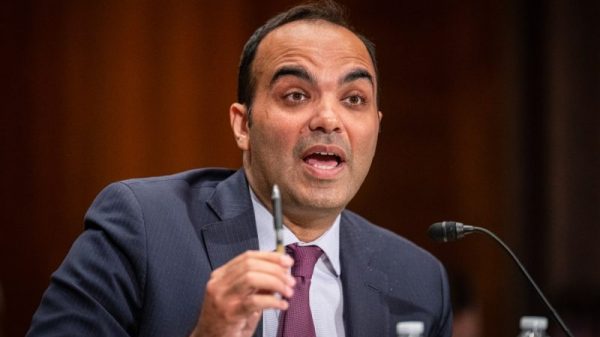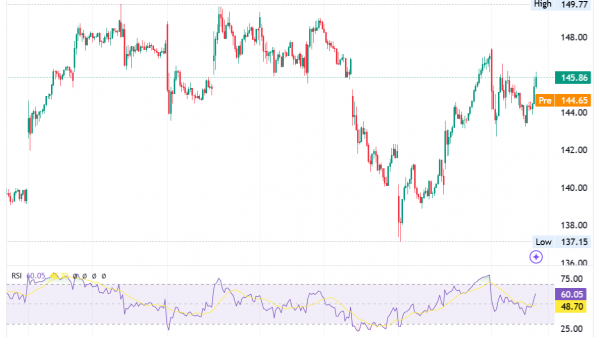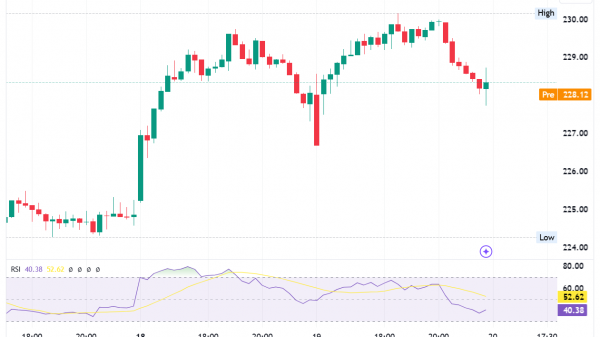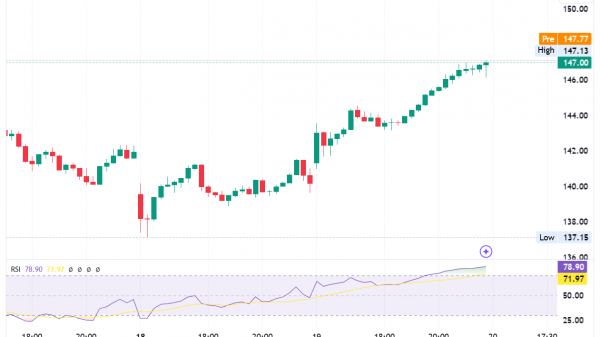Welcome to The Campaign Moment, your guide to the biggest developments in a 2024 election in which Democrats are about to find out how far “vibes” can take you.
(Make sure you are subscribed to this newsletter here. You can also hear my analysis weekly on Apple Podcasts, Spotify or wherever you get your podcasts.)
The big moment
Democrats have a new lease on political life with Vice President Kamala Harris atop their ticket. And while the presidential race remains close, the signs are getting better and better for them.
New swing state polling this week showed Harris taking a slight lead over Donald Trump (within the margin of error) in most of the decisive states in the presidential race. And a new Monmouth University poll out Wednesday showed Democrats leapfrogging Republicans on both enthusiasm and optimism, metrics that help turn out voters.
But just how optimistic should Democrats be about the fuller 2024 electoral picture? And could they even dream of winning the “trifecta” — i.e. the presidency and the House and Senate?
What seemed largely out of reach less than a month ago deserves some consideration in the vastly changed political universe.
The bottom line? A Democratic triple play remains tough, particularly when it comes to holding their narrow Senate majority, mostly because the map is so challenging for the party. But Harris’s candidacy has to tempt Democrats to start thinking bigger.
There is little question that Harris performing better than President Joe Biden is a major relief to congressional Democrats who were worried they would go down with him. But there is a real question as to just how much Harris recasts the House and Senate maps.
One key metric on this front is the so-called “generic ballot,” which asks voters to choose between a generic Democrat and a generic Republican for Congress. This is a good measure given that we don’t get regular polling in most Senate and House races, and given that there are fewer and fewer voters who split their tickets between parties.
The generic ballot hasn’t shifted as much as the presidential race in recent weeks, and it has long been neck-and-neck. But Democrats’ current one-point advantage in the FiveThirtyEight average is as good as at any point since mid-2023.
That would seem encouraging for Democrats’ efforts to flip the approximately four districts they need to erase Republicans’ razor-thin House majority. Still, Democrats probably need to win most of the “toss-up” House races, given that Republicans are generally favored in more districts.
Which brings us to the Democrats’ biggest hurdle: the Senate, where Democrats hold their own razor-thin majority, 51-49.
Democrats’ hopes there are a bit more complicated, for a couple reasons.
The big reason is that they are overwhelmingly playing defense, so even a slight advantage nationally might not be good enough. The Cook Political Report’s seven most competitive Senate races are all held by Democrats, and they’re defending a trio of red states: Montana, Ohio and West Virginia. One of those states, West Virginia, is in all likelihood gone with Sen. Joe Manchin III’s (I-W.Va.) retirement.
That means Democrats are basically starting at a 50-50 tie, and they also must win the White House to hold the tiebreaking vote (which is cast by the vice president).
The other reason the Senate is more complex is that Democrats in the vast majority of races were already running ahead of Biden — and often far ahead. In fact, Gabe Fleisher notes that Democrats have yet to trail in any quality poll in six of their eight most endangered states: Arizona, Michigan, Nevada, Ohio, Pennsylvania or Wisconsin.
Recent polling — from the New York Times/Siena College, AARP, Fox News, NPR/PBS/Marist College and Marquette University Law School — shows that’s continued. Democrats’ margins in those six states have ranged from up three points to up 14 points in recent weeks.
That suggests these Democrats could have survived even if Biden lost.
But they also would have been bucking recent history. As Fleisher also notes, only one out of 69 senators has won since 2020 in a state their party lost in the presidential race. And there’s no guarantee Democrats’ over-performances would have held up over time.
“We saw Senate Democrats outrunning Biden in previous polls even when he was doing poorly, though I’m not sure it fully captured where he was after the [June 27] debate,” said Jessica Taylor, Cook’s Senate race expert. “I think it’s just a smaller number by which they have to outrun the top of the ticket now.”
Assuming Harris continues to poll well, the big Senate races to watch would seem to be those other two, non-West Virginia red states: Ohio and especially Montana. Sen. Jon Tester (D-Mont.) has generally trailed in the limited polling we’ve seen, and that looks most likely to be the tipping point state for the Senate majority.
There’s also a question of whether Democrats can put one or two GOP-held seats in play — potentially Sen. Ted Cruz’s (R-Tex.) or Sen. Rick Scott’s (R-Fla.) — that could offset a loss elsewhere. Neither Cruz nor Scott won resoundingly in 2018 (by three points and one point, respectively), and some polls have shown a tighter race than some people might appreciate. For instance, Scott has recently led by the low to mid-single digits, and a Suffolk University poll this week showed Floridians disliked him by a 49 percent to 35 percent margin.
So if you’re a Democrat who dares to dream, keep an eye on Montana, Florida and Texas. Those could tell the tale about how much the electoral map has changed.
Another moment you may have missed
There are growing signs of Republican concern about Trump’s messaging. And increasingly, Republicans and Trump allies are going quite public with those concerns.
They’re practically begging Trump to change it up and move beyond falsehoods about Harris’s crowd sizes, her race, her intelligence and other non-policy issues.
To wit:
Nikki Haley on Tuesday on Fox News: “The campaign is not going to win talking about crowd sizes. It’s not going to win talking about what race Kamala Harris is. It’s not going to win talking about whether she’s dumb.”
Former House speaker Kevin McCarthy (R-Calif.): “You have got to make this race not on personalities. Stop questioning the size of her crowds and start questioning her position when it comes to what did she do as attorney general on crime.”
Former senior Trump adviser Kellyanne Conway: “The winning formula for President Trump is very plain to see: It’s fewer insults, more insights and that policy contrast.”
Vivek Ramaswamy on Tuesday on NPR: “I think a stronger focus on policy is the path to winning this election.”
Former Trump adviser Peter Navarro on Monday: “The current rally formula is simply not sufficiently focused on the very stark policy differences. … Instead, when Trump attacks Harris personally rather than on policy, Harris’s support among swing voters rises — particularly among women.”
Fox News host Sean Hannity last week on Trump’s attacks on Georgia Gov. Brian Kemp (R): “You know the thing is I’m sure they agree on like 85, 90 percent of the issues, and we’re 40 days away from early voting. We don’t have time for this. This is a real threat to the country.”
Trump hasn’t really heeded their advice, including at a news conference last week that barely touched on policy specifics. But he did just call another one for Thursday in New Jersey.
A momentous stat
1 percentage point
That’s Republicans’ current electoral college advantage, according to an analysis over the weekend by Washington Post data scientist Lenny Bronner.
The number represents the approximate gap between Harris’s slight current lead in The Washington Post national polling average and Trump’s slight edge in what looks to be the “tipping point” electoral college state, Michigan.
Why is that notable? Because it suggests a smaller electoral college edge for Republicans than we’ve previously seen in the Trump era. The gap between the popular vote and the margin in the “tipping point” state — i.e. the state that delivered the winner 270 electoral votes — was nearly three points in 2016 and nearly four points in 2020. That allowed Trump to lose the popular vote but win the electoral college in 2016, and it made for a much closer race than many people realized in 2020.
The conventional wisdom has long been that Democrats need to win the national popular vote by two or more points to win the electoral college. It’s still early, but as with other aspects of the new Harris vs. Trump race, that’s worth reconsidering. And as the chart above shows, it’s not as if the electoral college advantage has consistently landed in the GOP’s favor in recent decades.
Take a moment to read:
“Trump vs. Harris magnifies America’s generational and cultural divides” (Washington Post)
“Harris cuts Trump’s advantages on economy, immigration” (Washington Post)
“Tim Walz has good numbers so far, despite GOP attacks” (Washington Post)
“Kamala Harris honed her Senate identity as a Trump foil” (Washington Post)
“Trump was close to breaking his poll ceiling. Then Harris arrived.” (Washington Post)
“Harris Is Set to Lay Out an Economic Message Light on Detail” (New York Times)
“The One Policy Idea Uniting Trump and Harris” (Atlantic)

































